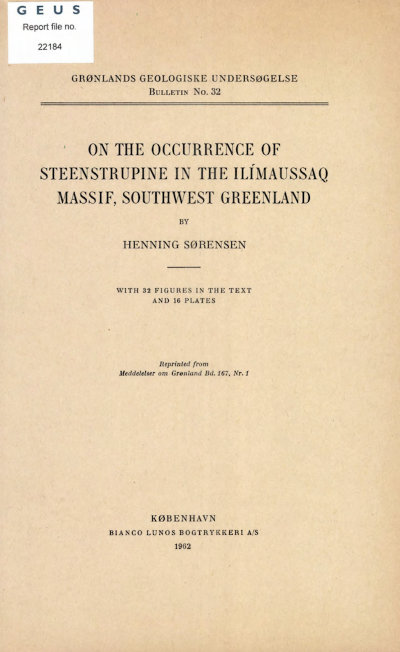On the occurrence of steenstrupine in the Ilímaussaq massif, Southwest Greenland
DOI:
https://doi.org/10.34194/bullggu.v32.6566Abstract
The rare mineral steenstrupine was first described from pegmatoid veins in the Ilímaussaq alkaline massif, South Greenland. It is now known to be of wide-spread occurrence in this massif, being present in agpaitic rocks (naujaite, sodalite foyaite and lujavrite) and in late veins of hydrothermal affinity. In the present paper three small areas within the Ilímaussaq massif have been selected for a rather detailed study of the mode of occurrence of the steenstrupine, namely the small island of Qeqertaussaq made up of naujaite which is cut by very thin veins of a black, lujavrite-like rock, felted ægirine and albite-analcime-natrolite rocks; the head of Kangerdluarssuk with thicker veins of black lujavrite and green ægirine felt cutting the naujaite; and the north coast of Tunugdliarfik which represents a deeper level in the intrusion, being composed of lujavrite with numerous inc1usions of naujaite. The naujaite of the last-named area is cut by thin veins of ægirine felt, acmite, albite and analcime-natrolite. The lujavrite here has apparently assimilated naujaitic material. Steenstrupine occurs in these three areas in lujavrite, late veins and in the naujaite adjacent to these rocks. It is also present in albite-analcime-natrolite· bearing replacement bodies in some zoned naujaite pegmatites. Some features favour a metasomatic origin of the lujavrite, but it is conc1uded that the combined observations are best explained by a magmatic interpretation. The lujavrite is clearly later than the naujaite, its intrusion being guided by the joints of the naujaite. Considerable tilting and rotation of the naujaite inclusions in lujavrite is seen in places. In some lujavrite veins it is seen that the mise en place of the lujavrite was preceded by the formation of ægirine felt along the naujaite joints. The intrusion of the lujavrite was accompanied and succeeded by the formation of thin veins containing one or more of the minerals acmite, arfvedsonite, albite, analcime and natrolite. In the lujavrite a very pure maximum microc1ine and a pure low albite have been formed in equilibrium indicating a low temperature of formation, probably of the order of 400 oC. The albite and in cases also the microc1ine, nepheline and sodalite of the lujavrite, may be replaced, to varying extent, by analcime, and, more rarely, by natrolite. This also favours a low temperature of formation of the lujavrite. At these low temperatures and in this very sodium-rich environment liquid immiscibility may have played a role as is mentioned in the discussion of peculiar spheroidal structures in the lujavrite. Some of the analcime of the lujavrite may be a primary precipitate of the lujavrite magma, but most analcime is probably secondary after the primary alkali· aluminium silicates. This analcitization is considered to be late magmatic. The sodium-water-rich rest liquid of the lujavrite may be squeezed out and has affected analcitization of the naujaite inclusions. These late fluids are also responsible for the formation of the late veins made up of albite, analcime, natrolite and a number of rare minerals containing rare earths, Nb, Th, Mn, Li, P, F, Zn and S. These elements are partly expelled from the lujavrite magma, partly leached out of the naujaite adjacent to the fractures by the percolating late fluids. The fact that the rare minerals (e.g. steenstrupine, britholite, monazite, lepidolite, schizolite, igdloite and sphalerite) of the late veins also occur in the analcitized lujavrite indicates that the formation of these minerals was closely connected with the later stages of crystallization of the lujavrite. The lujavrite and naujaite are rich in eudialyte; this mineral is rare in the steenstrupine-bearing rocks. It is therefore concluded that the eudialyte is stable at a higher temperature than the steenstrupine, monazite, etc. The steenstrupine-bearing replacement bodies of the naujaite pegmatites were formed simultaneously with the late veins and are thus considerably later than the naujaite and clearly formed from fluids of external origin, with respect to the primary pegmatite system. This feature is compared with the well-known replacement bodies in granite pegmatites. The chemical and physical properties of the late fluids and the mechanisms of transport and precipitation of the rare elements are discussed. New chemical analyses of ægirine, acmite, beryllium sodalite, chkalovite and igdloite and a number of partial chemical analyses of albite, analcime, microcline, monazite, natrolite, nepheline and sodalite are reported. Point countings have been made on the finer grained, more homogeneous rocks. The minerals of the rocks are briefly described, and a number of rare rock types are described and discussed.
Downloads
Published
Issue
Section
License
This article is distributed under a CC-BY 4.0 licence, permitting free redistribution and reproduction for any purpose, even commercial, provided proper citation of the original work. Author(s) retain copyright over the article contents.


